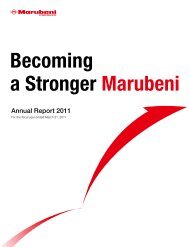Trust Recovery Growth Vitalization - Marubeni
Trust Recovery Growth Vitalization - Marubeni
Trust Recovery Growth Vitalization - Marubeni
You also want an ePaper? Increase the reach of your titles
YUMPU automatically turns print PDFs into web optimized ePapers that Google loves.
16 Financial Instruments<br />
Risk management<br />
Substantially all the derivative instruments which the Company and<br />
certain of its subsidiaries hold are utilized to hedge related market<br />
risks, and gains and losses on the derivative instruments are offset<br />
against losses and gains on the hedged assets and liabilities. The<br />
Company and certain of its subsidiaries also enter into derivative<br />
transactions for trading purposes. The Company has internal<br />
regulations regarding positions and loss limits and the actual<br />
positions and gains/losses are periodically reported to management.<br />
Although the Company and certain subsidiaries are exposed to credit<br />
risks in the event of nonperformance by the counterparties, such<br />
risks are minimized by avoiding a concentration of counterparties,<br />
selecting counterparties with high credit ratings and maintaining<br />
strict credit control.<br />
The Company and certain of its subsidiaries have separate<br />
departments which confirm their financial transactions with the<br />
counterparties from the departments which execute them. In<br />
addition, the Company has as its “middle-office” a “Risk Management<br />
Division,” in its Tokyo Head Office. The Risk Management<br />
Division independently performs direct confirmation procedures with<br />
the counterparties to each transaction and the month-end outstanding<br />
balances, analyzes various risks and exposures, reports the<br />
results of the analysis, and monitors and controls financial risks.<br />
Furthermore, the Risk Management Division obtains derivative<br />
transaction data from the financial subsidiaries and foreign corporate<br />
subsidiaries, reports to management periodically in cooperation with<br />
the related departments, and strengthens the Company’s unified<br />
global control over derivative transactions.<br />
Foreign exchange contracts<br />
The Company and certain of its subsidiaries conduct business in<br />
various foreign currencies and enter into foreign exchange contracts<br />
principally to hedge foreign currency denominated transactions and<br />
receivables and payables to minimize the effect of foreign currency<br />
fluctuations. Gains and losses related to the hedge ineffective<br />
portion and related to the portion of hedging instruments excluded<br />
from assessment of hedge effectiveness were not significant for the<br />
years ended March 31, 2005, 2004 and 2003.<br />
Interest rate swap agreements, including interest rate and<br />
currency swap agreements<br />
The Company and certain of its subsidiaries enter into interest rate<br />
swap agreements primarily to change the fixed interest rates on the<br />
principal of certain debt securities, loans receivable, short-term loans<br />
and long-term debt to floating interest rates. Gains and losses related<br />
to the hedge ineffective portion and related to the portion of hedging<br />
instruments excluded from assessment of hedge effectiveness were<br />
not significant for the years ended March 31, 2005, 2004 and 2003. In<br />
addition, the Company and certain of its subsidiaries enter into interest<br />
rate swap agreements for trading purposes on a limited basis.<br />
Commodity futures and forward contracts<br />
The Company and certain of its subsidiaries enter into commodity<br />
futures and forward contracts principally as a means of hedging the<br />
risks associated with certain inventories, commitments and<br />
forecasted transactions. Gains and losses related to the hedge<br />
ineffective portion and related to the portion of hedging instruments<br />
excluded from the assessment of hedge effectiveness were not<br />
significant for the years ended March 31, 2005, 2004 and 2003.<br />
Other derivative instruments<br />
The Company and certain of its subsidiaries utilize option contracts<br />
primarily to hedge the risks associated with changes in interest rates<br />
and exchange rates. Gains and losses related to the hedge ineffective<br />
portion and related to the portion of hedging instruments<br />
excluded from assessment of hedge effectiveness were not<br />
significant for the years ended March 31, 2005, 2004 and 2003. In<br />
<strong>Marubeni</strong> Corporation 2005 94 / 95<br />
addition, the Company and certain of its subsidiaries enter into other<br />
derivative contracts for trading purposes on a limited basis.<br />
Fair value of financial instruments<br />
The estimated fair value of the financial instruments of the Companies<br />
has been determined using available market information or other<br />
appropriate valuation methodologies. However, considerable<br />
judgment is required in interpreting market data to develop estimates<br />
of fair value. Consequently, the estimates are not necessarily<br />
indicative of the amounts that could be realized or would be paid in a<br />
current market exchange.<br />
The following methodologies and assumptions were used by the<br />
Companies in estimating the fair value disclosures of the financial<br />
instruments:<br />
Cash and cash equivalents, and time deposits: the carrying<br />
amounts of the cash and cash equivalents, and time deposits reflected<br />
in the consolidated balance sheets approximate their fair value.<br />
Investment securities, securities and other investments: the fair<br />
value of marketable equity securities is based on quoted market<br />
prices. The carrying amount of the marketable equity securities<br />
reflected in the balance sheets represents their fair value. The fair<br />
value of investments in debt securities is based on quoted market<br />
prices or estimated using discounted cash flow analyses, based on<br />
the estimated current rates offered to the issuers for securities with<br />
similar terms and remaining maturities. It was not practicable to<br />
estimate the fair value of the investments other than marketable<br />
equity securities and debt securities without incurring excessive<br />
costs. The carrying amount of the portion of the portfolio for which<br />
fair value could not be estimated was ¥238,806 million ($2,231,832<br />
thousand) and ¥257,157 million at March 31, 2005 and 2004,<br />
respectively, and represents the cost of this portion of the portfolio,<br />
which management believes is not impaired.<br />
Non-marketable securities of ¥167,362 million ($1,564,131 thousand),<br />
included in the above at March 31, 2005, included those<br />
securities that were not evaluated for impairment because the<br />
Company did not identify any events or changes in circumstances that<br />
might have had a significant adverse effect on the fair value of those<br />
investments, in the amounts of ¥166,742 million ($1,558,336 thousand).<br />
Long-term notes, loans and accounts receivable – trade: the fair<br />
value of long-term notes, loans and accounts receivable – trade is<br />
estimated using discounted cash flow analyses, based on the<br />
interest rates currently being offered to borrowers for similar<br />
long-term notes, loans and accounts receivable – trade with similar<br />
credit ratings. The fair value of accounts receivable with collectibility<br />
concerns is reflected at their carrying value less the related allowance<br />
for doubtful accounts.<br />
Short-term loans: the carrying amount of the short-term loans<br />
reflected in the accompanying consolidated balance sheets approximates<br />
their fair value.<br />
Long-term debt: the fair value of long-term debt is estimated<br />
using discounted cash flow analyses, based on the current<br />
borrowing rates for borrowing arrangements with similar terms and<br />
remaining maturities.<br />
Foreign exchange contracts: the fair value of foreign exchange<br />
contracts is estimated based on the quoted market prices of<br />
comparable contracts, adjusted where necessary for maturity<br />
differences.<br />
Interest rate swap agreements: the fair value of interest rate<br />
swap agreements is estimated using discounted cash flow analyses,<br />
based on the current swap rates for interest rate swap agreements<br />
with similar terms and remaining periods.<br />
Commodity futures and forward contracts: the fair value of<br />
commodity futures contracts is estimated based on the quoted<br />
market prices of comparable contracts, adjusted where necessary for<br />
maturity differences.



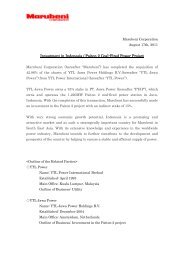
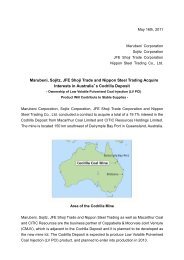
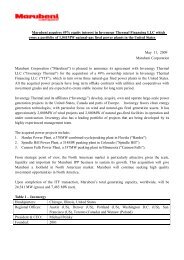

![[Chapter 2] Driving Growth: Expansion Under SG-12 - Marubeni](https://img.yumpu.com/4161147/1/190x248/chapter-2-driving-growth-expansion-under-sg-12-marubeni.jpg?quality=85)


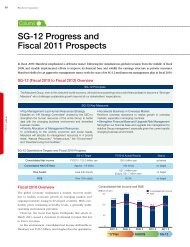

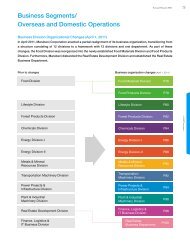
![[Chapter 4] Delivering Growth - Marubeni](https://img.yumpu.com/3464783/1/190x248/chapter-4-delivering-growth-marubeni.jpg?quality=85)
